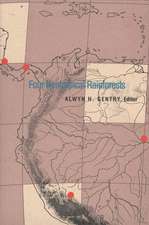A Field Guide to the Families and Genera of Woody Plants of Northwest South America: With Supplementary Notes on Herbaceous Taxa
Autor Alwyn H. Gentry Ilustrat de Rodolfo Vasquezen Limba Engleză Paperback – 8 mai 1996
To understand almost any part of the tropical rain forest's fabulously complex web of life, one must first learn to identify a bewildering array of plants. Alwyn Gentry's landmark book, completed just before his tragic death in 1993, is the only field guide to the nearly 250 families of woody plants in the most species-rich region of South America.
As a consummate field researcher, Gentry designed this guide to be not just comprehensive, but also easy to use in rigorous field conditions. Unlike many field guides, which rely for their identifications on flowers and fruits that are only present during certain seasons, Gentry's book focuses on characters such as bark, leaves, and odor that are present year-round. His guide is filled with clear illustrations, step-by-step keys to identification, and a wealth of previously unpublished data.
All biologists, wildlife managers, conservationists, and government officials concerned with the tropical rain forests will need and use this field guide.
Alwyn Gentry was one of the world's foremost experts on the biology of tropical plants. He was senior curator at the Missouri Botanical Garden, and was a member of Conservation International's interdisciplinary Rapid Assessment Program (RAP) team, which inventories the biodiversity of the most threatened tropical areas. From 1967 to 1993 he collected more than 80,000 plant specimens, many of them new to science.
As a consummate field researcher, Gentry designed this guide to be not just comprehensive, but also easy to use in rigorous field conditions. Unlike many field guides, which rely for their identifications on flowers and fruits that are only present during certain seasons, Gentry's book focuses on characters such as bark, leaves, and odor that are present year-round. His guide is filled with clear illustrations, step-by-step keys to identification, and a wealth of previously unpublished data.
All biologists, wildlife managers, conservationists, and government officials concerned with the tropical rain forests will need and use this field guide.
Alwyn Gentry was one of the world's foremost experts on the biology of tropical plants. He was senior curator at the Missouri Botanical Garden, and was a member of Conservation International's interdisciplinary Rapid Assessment Program (RAP) team, which inventories the biodiversity of the most threatened tropical areas. From 1967 to 1993 he collected more than 80,000 plant specimens, many of them new to science.
Preț: 446.84 lei
Preț vechi: 485.70 lei
-8% Nou
Puncte Express: 670
Preț estimativ în valută:
85.51€ • 88.73$ • 71.47£
85.51€ • 88.73$ • 71.47£
Carte disponibilă
Livrare economică 25 februarie-11 martie
Livrare express 08-14 februarie pentru 59.10 lei
Preluare comenzi: 021 569.72.76
Specificații
ISBN-13: 9780226289441
ISBN-10: 0226289443
Pagini: 920
Ilustrații: 291 line drawings
Dimensiuni: 165 x 254 x 51 mm
Greutate: 1.25 kg
Ediția:1
Editura: University of Chicago Press
Colecția University of Chicago Press
Locul publicării:United States
ISBN-10: 0226289443
Pagini: 920
Ilustrații: 291 line drawings
Dimensiuni: 165 x 254 x 51 mm
Greutate: 1.25 kg
Ediția:1
Editura: University of Chicago Press
Colecția University of Chicago Press
Locul publicării:United States
Cuprins
FOREWORD
ACKNOWLEDGEMENTS
LIST OF FIGURES
INTRODUCTION
KEY OUTLINE
KEY TO FAMILIES
KEY II - Leaves Alternate (and Compound)
IIA. Leaves bipinnate
IIB. Leaves simply pinnate (and alternate)
IIC. Leaves 3-foliolate
IID. Leaves palmately compound (and alternate)
KEY III - Leaves Simple and Opposite (or Whorled)
IIIA. Lianas
IIIB. Trees and shrubs
KEY IV - Leaves Simple and Alternate
IVA. Trees
IVB. Lianas with alternate simple leaves
SPECIAL HABIT LISTS AND FIGURES
FERNS AND GYMNOSPERMS
MONOCOTS
DICOTS
INDEX: COMMON NAMES
INDEX: SCIENTIFIC NAMES
ACKNOWLEDGEMENTS
LIST OF FIGURES
INTRODUCTION
KEY OUTLINE
KEY TO FAMILIES
KEY I - Leaves Opposite or Whorled (and Compound)
IA. Leaves bipinnate to biternate (and opposite)
IB. Leaves simply pinnately compound (and opposite)
IC. Leaves 3-foliolate
ID. Leaves palmately compound (and opposite)
IA. Leaves bipinnate to biternate (and opposite)
IB. Leaves simply pinnately compound (and opposite)
IC. Leaves 3-foliolate
ID. Leaves palmately compound (and opposite)
KEY II - Leaves Alternate (and Compound)
IIA. Leaves bipinnate
IIB. Leaves simply pinnate (and alternate)
IIC. Leaves 3-foliolate
IID. Leaves palmately compound (and alternate)
KEY III - Leaves Simple and Opposite (or Whorled)
IIIA. Lianas
IIIB. Trees and shrubs
KEY IV - Leaves Simple and Alternate
IVA. Trees
IVB. Lianas with alternate simple leaves
SPECIAL HABIT LISTS AND FIGURES
1. Leafless achlorophyllous parasites and saprophytes
2. Leafless plants with chlorophyllous stems
3. Tendrillate lianas
4. Anomalous liana stem cross sections
5. Some common whole-tree branching patterns
6. Ant domatia
7. Stilt roots
8. Spines
9. Strongly fenestrated trunks
2. Leafless plants with chlorophyllous stems
3. Tendrillate lianas
4. Anomalous liana stem cross sections
5. Some common whole-tree branching patterns
6. Ant domatia
7. Stilt roots
8. Spines
9. Strongly fenestrated trunks
FERNS AND GYMNOSPERMS
Ferns (mostly Cyatbeaceae)
Cycadaceae
Ephedraceae
Gnetaceae
Podocarpaceae
Cycadaceae
Ephedraceae
Gnetaceae
Podocarpaceae
MONOCOTS
Agavaceae
Araceae
Bromeliaceae
Burmanniaceae
Cannaceae
Commelinaceae
Cyclantbaceae
Cyperaceae
Dioscoreaceae
Eriocaulaceae
Gramineae
Haemodoraceae
Iridaceae
Liliaceae
Marantaceae
Musaceae
Orchidaceae
Palmae
Rapateaceae
Smilacaceae
Strelitziaceae
Triuridaceae
Velloziaceae
Zingiberaceae
Araceae
Bromeliaceae
Burmanniaceae
Cannaceae
Commelinaceae
Cyclantbaceae
Cyperaceae
Dioscoreaceae
Eriocaulaceae
Gramineae
Haemodoraceae
Iridaceae
Liliaceae
Marantaceae
Musaceae
Orchidaceae
Palmae
Rapateaceae
Smilacaceae
Strelitziaceae
Triuridaceae
Velloziaceae
Zingiberaceae
DICOTS
Acantbaceae
Actinidiaceae
Aizoaceae
Alzateaceae
Amaranthaceae
Anacardiaceae
Annonaceae
Apocynaceae
Aquifoliaceae
Araliaceae
Aristolochiaceae
Asclepiadaceae
Balanophoraceae
Basellaceae
Bataceae
Begoniaceae
Berberidaceae
Betulaceae
Bignoniaceae
Bixaceae
Bombacaceae
Boraginaceae
Brunelliaceae
Burseraceae
Buxaceae
Cactaceae
Calyceraceae
Campanulaceae
Capparidaceae
Caprifoliaceae
Caricaceae
Caryocaraceae
Caryophyllaceae
Celastraceae
Chenopodiaceae
Chloranthaceae
Chrysobalanaceae
Clethraceae
Cochlospermaceae
Columelliaceae
Combretaceae
Compositae
Actinidiaceae
Aizoaceae
Alzateaceae
Amaranthaceae
Anacardiaceae
Annonaceae
Apocynaceae
Aquifoliaceae
Araliaceae
Aristolochiaceae
Asclepiadaceae
Balanophoraceae
Basellaceae
Bataceae
Begoniaceae
Berberidaceae
Betulaceae
Bignoniaceae
Bixaceae
Bombacaceae
Boraginaceae
Brunelliaceae
Burseraceae
Buxaceae
Cactaceae
Calyceraceae
Campanulaceae
Capparidaceae
Caprifoliaceae
Caricaceae
Caryocaraceae
Caryophyllaceae
Celastraceae
Chenopodiaceae
Chloranthaceae
Chrysobalanaceae
Clethraceae
Cochlospermaceae
Columelliaceae
Combretaceae
Compositae
Eupatorieae
Vemonieae
Astereae
Inuleae
Heliantheae
Tageteae
Liabeae
Senecioneae
Anthemideae
Mutisieae
Lactuceae
Vemonieae
Astereae
Inuleae
Heliantheae
Tageteae
Liabeae
Senecioneae
Anthemideae
Mutisieae
Lactuceae
Connaraceae
Convolvulaceae
Coriariaceae
Cornaceae
Crassulaceae
Cruciferae
Cucurbitaceae
Cunoniaceae
Cyrillaceae
Dialypetalanthaceae
Dichapetalaceae
Dipterocarpaceae
Droseraceae
Ebenaceae
Elaeocarpaceae
Ericaceae
Erythroxylaceae
Euphorbiaceae
Fagaceae
Flacourtiaceae
Gentianaceae
Geraniaceae
Gesneriaceae
Goodeniaceae
Guttiferae
Haloragidaceae
Hamamelidaceae
Hernandiaceae
Hippocastanaceae
Hippocrateaceae
Humiriaceae
Hydrophyllaceae
Icacinaceae
Juglandaceae
Julianaceae
Krameriaceae
Labiatae
Lacistemataceae
Lauraceae
Lecythidaceae
Leguminosae
Convolvulaceae
Coriariaceae
Cornaceae
Crassulaceae
Cruciferae
Cucurbitaceae
Cunoniaceae
Cyrillaceae
Dialypetalanthaceae
Dichapetalaceae
Dipterocarpaceae
Droseraceae
Ebenaceae
Elaeocarpaceae
Ericaceae
Erythroxylaceae
Euphorbiaceae
Fagaceae
Flacourtiaceae
Gentianaceae
Geraniaceae
Gesneriaceae
Goodeniaceae
Guttiferae
Haloragidaceae
Hamamelidaceae
Hernandiaceae
Hippocastanaceae
Hippocrateaceae
Humiriaceae
Hydrophyllaceae
Icacinaceae
Juglandaceae
Julianaceae
Krameriaceae
Labiatae
Lacistemataceae
Lauraceae
Lecythidaceae
Leguminosae
Caesalpinioideae
Mimosoideae
Papilionoideae
Mimosoideae
Papilionoideae
Lentibulariaceae
Lepidobotryaceae
Linaceae
Loasaceae
Loganiaceae
Loranthaceae
Lythraceae
Magnoliaceae
Malesherbiaceae
Malpighiaceae
Marcgraviaceae
Martyniaceae
Melastomataceae
Meliaceae
Menispermaceae
Monimiaceae
Moraceae
Myricaceae
Myristicaceae
Myrsinaceae
Myrtaceae
Nolanaceae
Nyctaginaceae
Lepidobotryaceae
Linaceae
Loasaceae
Loganiaceae
Loranthaceae
Lythraceae
Magnoliaceae
Malesherbiaceae
Malpighiaceae
Marcgraviaceae
Martyniaceae
Melastomataceae
Meliaceae
Menispermaceae
Monimiaceae
Moraceae
Myricaceae
Myristicaceae
Myrsinaceae
Myrtaceae
Nolanaceae
Nyctaginaceae
Ochnaceae
Olacaceae
Oleaceae
Onagraceae
Opiliaceae
Oxalidaceae
Papaveraceae
Passifloraceae
Phytolaccaceae
Piperaceae
Plantaginaceae
Plumbaginaceae
Polemoniaceae
Polygalaceae
Portulacaceae
Proteaceae
Pyrolaceae
Quiinaceae
Rafflesiaceae
Ranunculaceae
Rharnnaceae
Rhizophoraceae
Rosaceae
Rubiaceae
Rutaceae
Sabiaceae
Salicaceae
Santalaceae
Sapindaceae
Sapotaceae
Saxifragaceae
Scrophulariaceae
Simaroubaceae
Solanaceae
Staphyleaceae
Styracaceae
Symplocaceae
Theophrastaceae
Thymelaeaceae
Tiliaceae
Trigoniaceae
Tropaeolaceae
Turneraceae
Ulmaceae
Umbelliferae
Urticaceae
Valerianaceae
Verbenaceae
Violaceae
Vitaceae
Vochysiaceae
Winteraceae
Olacaceae
Oleaceae
Onagraceae
Opiliaceae
Oxalidaceae
Papaveraceae
Passifloraceae
Phytolaccaceae
Piperaceae
Plantaginaceae
Plumbaginaceae
Polemoniaceae
Polygalaceae
Portulacaceae
Proteaceae
Pyrolaceae
Quiinaceae
Rafflesiaceae
Ranunculaceae
Rharnnaceae
Rhizophoraceae
Rosaceae
Rubiaceae
Rutaceae
Sabiaceae
Salicaceae
Santalaceae
Sapindaceae
Sapotaceae
Saxifragaceae
Scrophulariaceae
Simaroubaceae
Solanaceae
Staphyleaceae
Styracaceae
Symplocaceae
Theophrastaceae
Thymelaeaceae
Tiliaceae
Trigoniaceae
Tropaeolaceae
Turneraceae
Ulmaceae
Umbelliferae
Urticaceae
Valerianaceae
Verbenaceae
Violaceae
Vitaceae
Vochysiaceae
Winteraceae
INDEX: COMMON NAMES
INDEX: SCIENTIFIC NAMES










